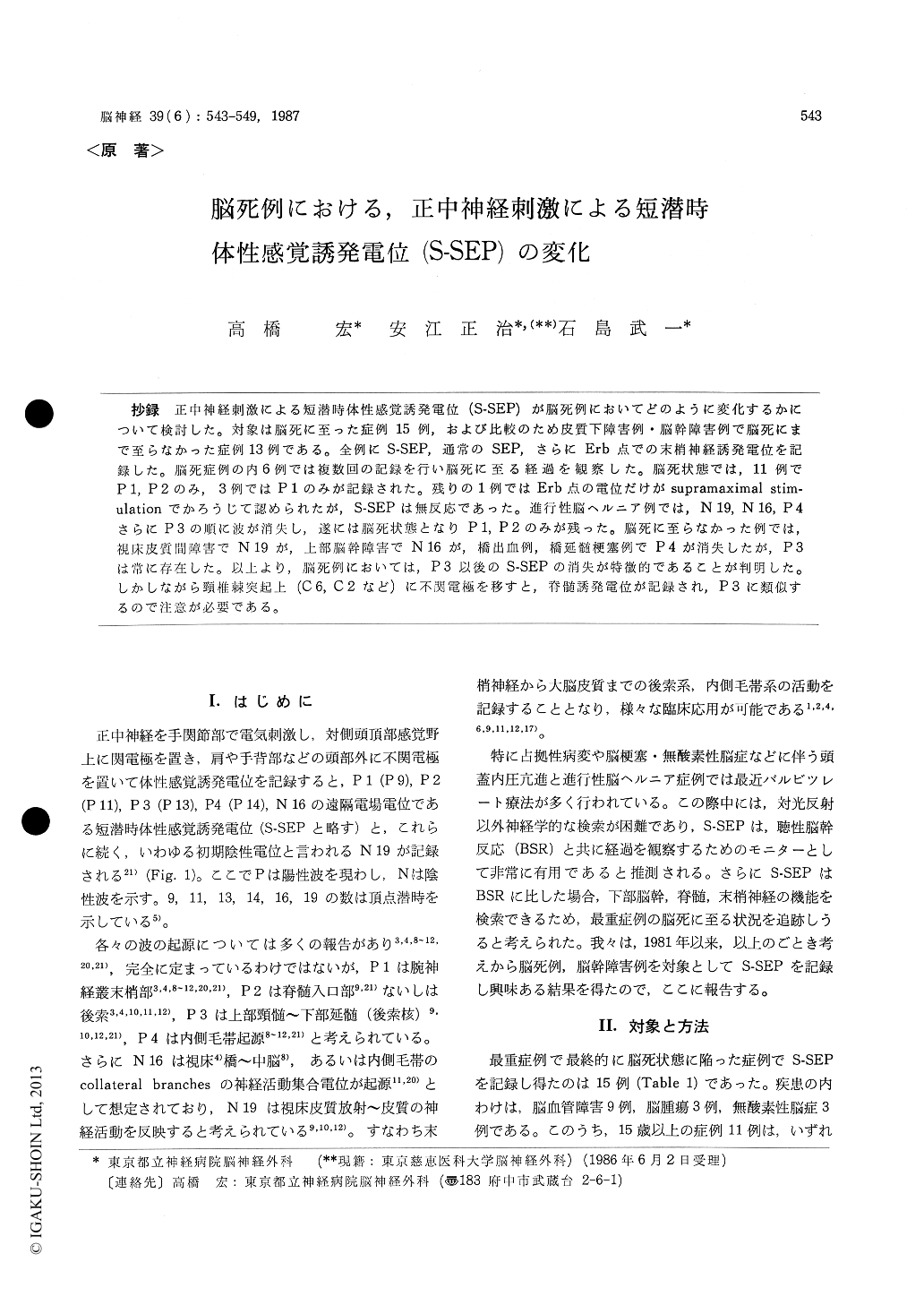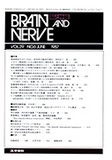Japanese
English
- 有料閲覧
- Abstract 文献概要
- 1ページ目 Look Inside
抄録 正中神経刺激による短潜時体性感覚誘発電位(S-SEP)が脳死例においてどのように変化するかについて検討した。対象は脳死に至った症例15例,および比較のため皮質下障害例・脳幹障害例で脳死にまで至らなかった症例13例である。全例にS-SEP,通常のSEP,さらにErb点での末梢神経誘発電位を記録した。脳死症例の内6例では複数回の記録を行い脳死に至る経過を観察した。脳死状態では,11例でP1,P2のみ,3例ではP1のみが記録された。残りの1例ではErb点の電位だけがsupramaximal stim-ulationでかろうじて認められたが,S-SEPは無反応であった。進行性脳ヘルニア例では,N19, N16, P4さらにP3の順に波が消失し,遂には脳死状態となりP1, P2のみが残った。脳死に至らなかった例では,視床皮質闇障害でN19が,上部脳幹障害でN16が,橋出血例,橋延髄梗塞例でP4が消失したが,P3は常に存在した。以上より,脳死例においては,P3以後のS-SEPの消失が特徴的であることが判明した。しかしながら頸椎棘突起上(C6,C2など)に不関電極を移すと,脊髄誘発電位が記録され,P3に類似するので注意が必要である。
Short latency SEPs (S-SEPs) to median nerve stimulation consist of positive waves of P1, P2, P3 and P4, followed by negative waves of N 16 and N 19. These potentials reflect activities of peripheral nerve, dorsal column of the cervical cord and medial lemniscus. The origins of these waves are considered as follows, P1-peripheral part of the brachial plexus, P2-the entry into the spinal cord or the dorsal column, P3-dorsal column nucleus or upper cervical cord, P4- the medial lemniscus, N16-rostral brain stem or the thalamus, and N19-thalamocortical projection or the cortex.
The purpose of the present study is to elucidate changes of S-SEPs in brain dead patients.
Fifteen brain dead patients were examined with S-SEPs. In addition to that, thirteen cases with lesions of subcortical or the brain stem but not in the state of brain death were studied for thecontrol.
S-SEPs with non-cephalic references, convention-al SEPs with earlobe reference and the evoked potentials at the Erb's point were recorded in all these cases.
Serial recordings were performed in six brain dead cases during the process of rostro-caudal deterioration of the brain stem functions due to cerebral herniation.
In the state of brain death, only P1 and P2 were recorded in eleven cases, and in three cases, only P1 was recorded. The other case with anoxic brain damage showed flat S-SEPs and the evoked potentials at the Erb's point could merely be ob-tained by the supramaximal stimulation.
In a case with massive intracerebral and ventri-cular hematoma caused by Moyamoya disease, serial S-SEPs disclosed that N19, N16, P4 and P3 disappeared in the order named, as cerebral herniation exacerbated progressively and finally only P1 and P2 could be recorded in the state of brain death as mentioned above.
In cases studied for comparison, N19 disappeared when the lesion located in the sensory pathway between the thalamus and the cortex. N16 disap-peared when the lesion occupied the upper brain stem. And the cases with pontine hematoma or ponto-medullary infarction, P1, P2 and P3 could be recorded.
In conclusion, S-SEPs proved to be an usefull supplementary diagnostic method to evaluate the state of impending brain death or brain death. And in cases whose clinical state fulfill the criteria of brain death, S-SEPs show always disappearance of P3 and the following waves when the non-cephalic reference placed not over the cervical spine but over the shoulder contralateral to the site of stimulation.

Copyright © 1987, Igaku-Shoin Ltd. All rights reserved.


